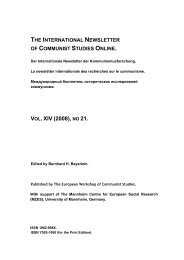11RXNdQ
11RXNdQ
11RXNdQ
Create successful ePaper yourself
Turn your PDF publications into a flip-book with our unique Google optimized e-Paper software.
From One China to Another *<br />
The picturesque has its origins in war and a refusal to understand the enemy: our<br />
enlightenment about Asia actually came to us first from irritated missionaries and from<br />
soldiers. Later came travellers – traders and tourists – who are soldiers that have cooled<br />
off. Pillaging is called shopping, and rape is practised onerously in specialized shops. But<br />
the basic attitude has not changed: the natives are killed less frequently but they are<br />
scorned collectively, which is the civilized form of massacre; the aristocratic pleasure of<br />
counting the differences is savoured. ‘I cut my hair, he plaits his; I use a fork, he uses<br />
chopsticks; I write with a goose quill, he draws characters with a paintbrush; I have ideas<br />
which are straight, and his are bent: have you noticed that he is horrified by movement in<br />
a straight line, that he is only happy if everything goes sideways?’ This is called the game<br />
of anomalies: if you find another one, if you discover another reason for not<br />
understanding, you will be given a prize for sensitivity in your own country. You must<br />
not be surprised if those who in this way reconstruct those who resemble them, like a<br />
mosaic of irreducible differences, then wonder how anyone can be Chinese.<br />
As a child, I was a victim of the picturesque: everything had been done to make the<br />
Chinese intimidating. I was told about rotten<br />
* Preface to D’une Chine à l’autre, by Henri Cartier-Bresson and Jean-Paul Sartre, Paris, Editions<br />
Robert Delpire, 1954.<br />
eggs – the Chinese were rather partial to these – of men sawn between two planks of<br />
wood, of piping and discordant music. In the world which surrounded me, among all the<br />
things and creatures, there were some which were referred to as Chinese. They were tiny<br />
and terrible, slipped between your fingers, attacked from behind, burst out suddenly in a<br />
ridiculous din, shadows sliding like fishes along the glass of an aquarium, dim lanterns,<br />
incredible and futile refinements, ingenious tortures, jingling hats. There was also the<br />
Chinese soul, which I was simply told was inscrutable. ‘The Orientals, you see …’ The<br />
Negroes did not worry me; I had been taught that they were good dogs. With them, we<br />
were still among mammals. But the Asians frightened me, like those crabs in the rice<br />
fields which dart between two rows, like those locusts which descend on the great plains<br />
and devastate everything. We are lords of the fishes, lions, rats and monkeys; the Chinese<br />
are superior arthropods, they rule over the arthropods.<br />
Then came Michaux who was the first to show the Chinese without a soul or a shell,<br />
China without lotus or Loti.<br />
A quarter of a century later, Cartier-Bresson’s album completes the demystification.<br />
There are photographers who encourage war because they produce literature.<br />
They seek out a Chinese who looks more Chinese than the others; in the end they find<br />
one. They make him adopt a typically Chinese pose and surround him with chinoiseries.<br />
What have they captured on film? One Chinaman? No … the Idea of what is Chinese.




